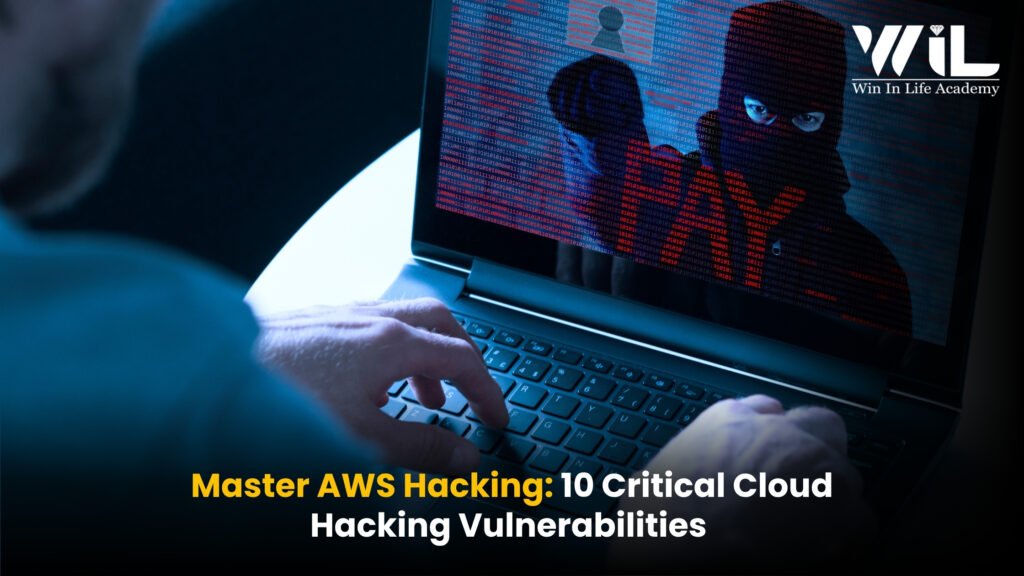Amazon Web Services (AWS) stands out, powering an immense portion of the world’s online services in this digital infrastructure. Its unparalleled scalability, flexibility, and robust feature set have made it the go-to platform for businesses of all sizes. However, great power comes with great responsibility – and equally great potential for exploitation if not secured meticulously. The captivation of cloud resources, loaded with sensitive data and critical applications, makes AWS hacking as an increasingly attractive target for malicious actors.
This comprehensive guide delves into the intricate world of AWS hacking, exploring common vulnerabilities, sophisticated attack vectors, and the indispensable role of proactive defense. For aspiring cybersecurity professionals, understanding these nuances is not just advantageous, but absolutely essential in today’s threat landscape.
The very essence of ethical hacking lies in understanding the adversary’s mindset, identifying weaknesses before they are exploited, and fortifying defenses proactively. This principle is never more critical than in the cloud, where misconfigurations or overlooked vulnerabilities can have catastrophic consequences, leading to data breaches, service disruptions, and reputational damage.
As the demand for skilled cybersecurity professional’s skyrockets, a deep understanding of cloud security, particularly AWS hacking techniques, becomes a cornerstone of a successful career. This is where specialized training, like the Win in Life Academy’s EC Council Certified Ethical Hacker program, proves invaluable, equipping individuals with the knowledge and practical skills to navigate and secure complex cloud environments.
Enroll Now: Ethical Hacking Course
The AWS Attack Surface
The transparency in breadth and depth of AWS services presents a multifaceted attack surface. Unlike traditional on-premises infrastructures where the perimeter is often well-defined, the cloud’s shared responsibility model introduces new complexities. While AWS is responsible for the security of the cloud (the underlying infrastructure), users are responsible for security in the cloud (their data, configurations, and applications). This distinction is crucial, as many successful AWS attacks stem from user-side misconfigurations or vulnerabilities in deployed applications.
Understanding the typical phases of an AWS attack provides a valuable framework for both offense and defense:
- Reconnaissance: Attackers begin by gathering information about the target’s AWS environment. This can involve passive techniques like open-source intelligence (OSINT) to identify publicly exposed S3(Simple Storage Service) buckets, misconfigured DNS records, or leaked credentials. Active reconnaissance might involve scanning open ports, enumerating AWS services, or attempting to discover subdomains.
- Initial Access: This phase aims to gain a foothold within the AWS environment. Common methods include exploiting vulnerable web applications hosted on EC2 instances, leveraging misconfigured IAM roles, phishing attacks to acquire credentials, or exploiting exposed API keys.
- Persistence: Once inside, attackers strive to maintain access, even if their initial entry point is discovered. This might involve creating new IAM users, backdooring EC2 instances, or modifying security group rules to allow future access.
- Privilege Escalation: A common goal for attackers is to elevate their privileges to gain broader access to sensitive resources. This often involves exploiting misconfigured IAM policies, leveraging compromised EC2 instance roles, or identifying overly permissive permissions.
- Lateral Movement: After gaining initial access, attackers seek to move across the AWS environment, discovering and compromising additional resources. This can involve pivoting from a compromised EC2 instance to other instances, accessing S3 buckets, or interacting with other AWS services.
- Data Exfiltration & Impact: The ultimate objective for many attackers is to exfiltrate sensitive data, disrupt operations, or inject malicious code. This could involve copying data from S3 buckets, launching denial-of-service attacks, or deploying ransomware.
10 Critical AWS Hacking Vulnerabilities

While the specific attack vectors are constantly evolving, several core vulnerability categories consistently emerge as prime targets for AWS hacking. Understanding these common weaknesses is the first step towards building a resilient cloud security posture.
1. Identity and Access Management (IAM) Misconfigurations
IAM is the cornerstone of AWS security, controlling who can do what within your environment. Misconfigurations here are arguably the most common and devastating vulnerability.
- Overly Permissive IAM Policies: Granting more permissions than necessary to users, roles, or groups. For instance, an IAM user only needs to read S3 buckets to be granted s3: * permissions. An attacker gaining control of such a user immediately has extensive access.
- Root Account Compromise: The AWS root account possesses absolute power. Any compromise here is catastrophic. Lack of MFA, weak passwords, or exposure to root access keys are critical errors.
- Weak or Reused Credentials: Using default, weak, or reused passwords for IAM users significantly increases the risk of compromise through brute-force or credential stuffing attacks.
- Unrestricted IAM Role Trust Policies: IAM roles allow services or EC2 instances to assume specific permissions. If the trust policy of a role is too broad (e.g., allowing any AWS account to assume it), it becomes a major vulnerability.
- Unrotated Access Keys: Long-lived access keys that are never rotated increase the window of opportunity for an attacker if those keys are compromised.
2. S3 Bucket Misconfigurations
Amazon S3 is widely used for data storage. However, misconfigured S3 buckets are a persistent source of data breaches.
- Publicly Accessible S3 Buckets: Accidentally or intentionally making S3 buckets publicly readable or writable without proper authorization expose sensitive data to the entire internet. This is a classic example of how easily private data can become public, as highlighted in numerous AWS data breach incidents.
- Lack of Versioning or MFA Delete: Without versioning, accidental or malicious deletion of objects can lead to irreversible data loss. MFA Delete adds an extra layer of security for critical object deletions.
- Incorrect Bucket Policies and ACLs: Overly permissive bucket policies or Access Control Lists (ACLs) can grant unintended access to data.
- Unencrypted Data: Storing sensitive data in S3 without encryption (both in transit and at rest) makes it vulnerable if the bucket is compromised.
3. Vulnerable EC2 Instances and Applications
EC2 instances are virtual servers in the cloud. Just like on-premises servers, they are exposed to operating system and application-level vulnerabilities.
- Unpatched Operating Systems and Software: Failure to regularly update and patch the OS and applications running on EC2 instances leaves them vulnerable to known exploits.
- Open Ports and Unrestricted Security Groups: Leaving unnecessary ports open or configuring overly permissive security group rules (e.g., SSH accessible from 0.0.0.0/0) creates direct pathways for attackers.
- Vulnerable Web Applications: Web applications deployed on EC2 instances are prime targets for attacks like SQL injection, cross-site scripting (XSS), and deserialization vulnerabilities. These are often the initial entry points for attackers.
- Weak SSH Keys: Using weak or compromised SSH keys to access EC2 instances can lead to unauthorized access.
4. Compromised API Keys
AWS services are managed through APIs. Compromised API keys can grant an attacker programmatic access to your AWS environment, mimicking the permissions associated with those keys.
- Hardcoded API Keys in Code Repositories: Publicly accessible code repositories (e.g., GitHub) often inadvertently expose API keys, leading to rapid compromise.
- Leaked API Keys in Logs or Configuration Files: API keys left in insecure log files, configuration files, or build artifacts can be easily discovered.
- Overly Permissive API Keys: Granting API keys with broader permissions than required for their intended function increases the blast radius of a compromise.
5. Insecure Network Configurations
While AWS hacking manages the underlying network infrastructure, users are responsible for configuring their Virtual Private Clouds (VPCs) and associated network components.
- Misconfigured VPCs and Subnets: Poorly designed VPCs without proper segmentation can allow attackers to move laterally across an environment more easily.
- Insecure Network Access Control Lists (NACLs): NACLs operate at the subnet level and can be misconfigured to allow unwanted traffic.
- Lack of Private Endpoints (VPC Endpoints): Not using private endpoints for services like S3 or DynamoDB can force traffic over the public internet, increasing exposure.
- Exposure of Databases to the Internet: Relational Database Service (RDS) instances or other databases accidentally exposed to the public internet are prime targets for direct attacks.
6. Lack of Logging and Monitoring
Visibility is paramount in cybersecurity. Without comprehensive logging and active monitoring, detecting and responding to AWS hacking attempts becomes incredibly challenging.
- Disabled CloudTrail: AWS CloudTrail provides an activity log of actions taken by a user, role, or AWS service. Disabling it leaves blind spots for attackers.
- Lack of CloudWatch Alarms: Not setting up CloudWatch alarms for suspicious activities (e.g., unusual API calls, repeated failed logins, changes to security groups) delays detection and response.
- Insufficient VPC Flow Logs: VPC Flow Logs record network traffic information. Not enabling or analyzing them hinders forensic investigations.
- Ignoring GuardDuty Findings: AWS GuardDuty is a threat detection service. Ignoring its findings allows threats to persist undetected.
7. Serverless Function (Lambda) Vulnerabilities
Serverless computing with AWS Lambda is gaining popularity. However, it introduces its own set of security considerations.
- Insecure Code in Lambda Functions: Just like any application, Lambda functions can have code vulnerabilities (e.g., injection flaws, insecure deserialization).
- Overly Permissive Lambda Execution Roles: Granting Lambda functions more permissions than they need to execute their intended task.
- Lack of Input Validation: Unvalidated input to Lambda functions can lead to injection attacks.
- Environmental Variable Exposure: Storing sensitive information like API keys directly in Lambda environment variables instead of using AWS Secrets Manager.
8. Container Security Weaknesses (ECS/EKS)
The adoption of containers (Docker, Kubernetes) orchestrated by AWS Elastic Container Service (ECS) or Elastic Kubernetes Service (EKS) introduces new layers of complexity.
- Vulnerable Container Images: Using container images with known vulnerabilities as a base for your applications.
- Misconfigured ECS Task Definitions or EKS Pods: Overly permissive IAM roles for tasks, exposed ports, or lack of resource limits.
- Lack of Network Segmentation between Containers: Allowing containers to communicate freely can facilitate lateral movement.
- Insecure Registry Access: Unsecured access to container registries (e.g., ECR) can lead to the injection of malicious images.
9. Lack of Data Encryption (At Rest and In Transit)
While AWS provides encryption options, it’s the user’s responsibility to implement them effectively.
- Unencrypted EBS Volumes: EC2 instances can have unencrypted Elastic Block Store (EBS) volumes, making data vulnerable if the instance is compromised.
- Lack of SSL/TLS for Public-Facing Services: Websites and APIs exposed to the internet without proper SSL/TLS encryption can expose data in transit.
- Ignoring AWS Key Management Service (KMS): Not leveraging KMS for managing encryption keys can weaken overall data security.
10. Phishing and Social Engineering
Despite technical controls, the human element remains a significant vulnerability. Attackers frequently target individuals to gain access to AWS credentials.
- Phishing Attacks: Crafting convincing emails or websites to trick users into divulging their AWS credentials.
- Social Engineering: Manipulating individuals into performing actions that compromise security (e.g., granting temporary access, revealing sensitive information).
- Insider Threats: Malicious or negligent insiders can intentionally or unintentionally expose AWS resources.
A Proactive Approach to AWS Security

Mitigating these AWS hacking risks requires a multi-layered, proactive approach. It’s not just about implementing controls but also about continuous monitoring, regular auditing, and fostering a strong security culture.
Implement Strong IAM Policies with Least Privilege:
- Grant only the necessary permissions to users, roles, and services.
- Use IAM Access Analyzer to identify unintended external access.
- Regularly review and audit IAM policies.
- Enable Multi-Factor Authentication (MFA) for all IAM users, especially the root account.
- Rotate access keys regularly.
Secure S3 Buckets Rigorously:
- Never make S3 buckets publicly readable or writable unless necessary and with strict controls.
- Use S3 Block Public Access at the account level.
- Implement strong bucket policies and ACLs.
- Enable default encryption for all new S3 objects.
- Utilize S3 Versioning and MFA Delete for critical data.
Harden EC2 Instances and Applications:
- Apply security patches and updates promptly.
- Use hardened AMIs (Amazon Machine Images).
- Implement strict security group rules, allowing only necessary inbound and outbound traffic.
- Conduct regular vulnerability scanning and penetration testing on applications and instances.
- Use SSH keys with passphrases and store them securely.
Manage API Keys Securely:
- Never hardcode API keys in code.
- Use AWS Secrets Manager or AWS Systems Manager Parameter Store to store and retrieve sensitive credentials.
- Rotate API keys frequently.
- Ensure API keys have the minimum necessary permissions.
Design Secure Network Architectures:
- Implement well-segmented VPCs with private and public subnets.
- Utilize Network Access Control Lists (NACLs) and Security Groups effectively.
- Use VPC Endpoints for private access to AWS services.
- Never expose databases directly to the public internet.
Embrace Comprehensive Logging and Monitoring:
- Enable CloudTrail across all regions and send logs to an S3 bucket for long-term storage and analysis.
- Set up CloudWatch alarms for critical security events.
- Enable VPC Flow Logs for network traffic visibility.
- Utilize AWS GuardDuty for intelligent threat detection.
- Integrate logs with a Security Information and Event Management (SIEM) system for centralized analysis.
Fortify Serverless Security:
- Review Lambda function code for vulnerabilities.
- Grant Lambda execution roles the principle of least privilege.
- Implement robust input validation.
- Use Secrets Manager for sensitive environmental variables.
Prioritize Container Security:
- Scan container images for vulnerabilities before deployment.
- Use trusted base images.
- Implement strict IAM rules for ECS tasks and EKS pods.
- Apply network policies to control container communication.
- Secure access to container registries.
Enforce Data Encryption Everywhere:
- Encrypt EBS volumes.
- Use SSL/TLS for all public-facing services.
- Leverage AWS Key Management Service (KMS) for centralized key management and encryption.
- Encrypt data at rest in S3, RDS, and other storage services.
Cultivate a Security-Aware Culture:
- Provide regular cybersecurity awareness training for all employees.
- Conduct simulated phishing exercises.
- Implement strong access control policies and multi-factor authentication for all internal systems.
- Develop and regularly test incident response plans.
The Significant Role of Certified Ethical Hacking in Cloud Security

The landscape of AWS hacking is dynamic, with new vulnerabilities and attack methods emerging constantly. This necessitates a workforce equipped with advanced skills and a proactive mindset. This is precisely where a formal education in cyber hacking course becomes paramount. The EC Council Certified Ethical Hacker (CEH) program, for instance, provides a structured and comprehensive curriculum that covers not only foundational hacking concepts but also dives deep into cloud security, including AWS-specific vulnerabilities and exploitation techniques.
A CEH certified ethical hacker training is not merely a penetration tester; they are a cybersecurity professional with a profound understanding of network security, system vulnerabilities, and, crucially, cloud environments. They are trained to think like an attacker, enabling them to identify weaknesses before malicious actors do. The certified ethical hacker training equips individuals with practical skills in reconnaissance, scanning, enumeration, vulnerability analysis, system hacking, web application hacking, and importantly, cloud security. This holistic approach ensures that professionals are well-rounded and capable of securing diverse IT infrastructures, including complex AWS hacking deployments.
For anyone serious about a career in cybersecurity, particularly in the burgeoning field of cloud security, undertaking an ethical hacking course that leads to certifications like the CEH certified ethical hacker is a strategic investment. It validates your expertise, demonstrates your commitment to the field, and opens doors to a plethora of exciting opportunities in an industry desperately in need of skilled professionals.
Whether it’s securing highly sensitive financial data in S3 buckets, preventing privilege escalation through IAM roles, or defending against sophisticated web application attacks on EC2, the knowledge gained from such training is invaluable.
Final Thoughts
The era of cloud computing has introduced unprecedented efficiency and innovation, but it has also magnified the importance of robust cybersecurity. AWS hacking is not a theoretical threat; it is a very real and persistent challenge that demands constant vigilance and specialized expertise. From misconfigured IAM policies to vulnerable EC2 instances and exposed S3 buckets, the potential pitfalls are numerous. However, with the right knowledge, tools, and training, these challenges can be effectively met. By understanding the intricacies of AWS hacking security, implementing proactive defense strategies, and fostering a culture of security awareness, organizations can significantly reduce their risk profile.
For individuals passionate about safeguarding digital assets and making a tangible impact in the cybersecurity domain, the path forward is clear. Investing in your skills, particularly through industry-recognized certifications, is the key to unlocking your full potential.
Ready to master the art of cyber hacking course and become a certified protector of the cloud?
Elevate your career and secure your future with comprehensive ethical hacking training that covers the most critical aspects of cloud security, including AWS hacking. Visit Win in Life Academy today to explore their cutting-edge courses and take the definitive step towards becoming a certified cybersecurity expert.
References
AWS Hacking
https://github.com/opendevsecops/guide-aws-hacking
AWS Data Breach: What & How It Happened?
https://www.twingate.com/blog/tips/AWS-data-breach
What Years of AWS Hacking Tells Us About Building Secure Apps
https://www.hackerone.com/blog/what-years-aws-hacking-tells-us-about-building-secure-apps





